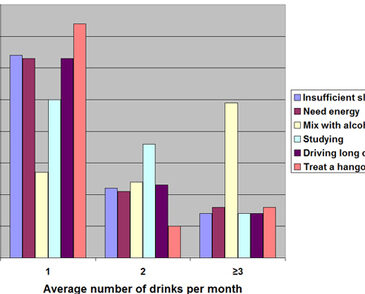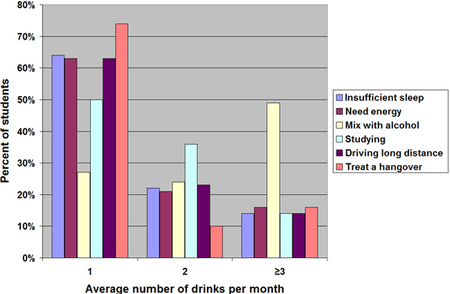Approximately 70% of college students report not getting enough sleep (Engle-Friedman et al., 2003), and many students resort to caffeine consumption to remedy sleep deprivation. Since the late 1990’s, energy drinks like Red Bull have been supplementing coffee and soda as sources of caffeine (Ellis, 2006). According to the Mayo Clinic, many popular energy drinks contain as much or more caffeine as a cup of coffee (Mayo Clinic, 2007). The increasing popularity of energy drinks with high caffeine levels among college students might lead to an increased number who suffer from the side effects of caffeine consumption (e.g., dehydration, increased blood pressure, irritability, nervousness, and the potential for substance dependence) (SAMHSA, 2007). In this weeks’ STASH, we examine the prevalence of energy drink consumption among college students, reasons for use of these beverages, and some of the common side effects that result from such use (Malinauskas, Aeby, Overton, Carpenter-Aeby, & Barber-Heidal, 2007).
Malinauskas et al. (2007) recruited 496 college students to participate in a 19 question anonymous self-report survey about energy drink consumption. The respondents volunteered from a state university in the Central Atlantic region of the United States with an undergraduate population of approximately 18,000 students. Researchers varied the time of day and day of the week that they recruited students; they also stationed themselves at various public locations across the campus to diversify the sample. Investigators provided a self-administered survey, which asked for participant age and gender, the average number of energy drinks per month during the current semester, reasons for energy drink consumption, and side effects of energy drink consumption.
This study does not report the number of students who refused to take part in the survey, consequently, it is not possible to calculate a participation rate. However, among the 496 college students that did participate, 51% (N = 253) reported drinking more than one energy drink per month during the current semester. Female college students (53%) were more likely than their male counterparts (42%) to report drinking more than one energy drink per month, χ2 (1, N = 496) = 6.46, p = 0.01. As Figure 1 shows, reasons for consuming energy drinks included: insufficient sleep (67%), to increase energy (65%), and to drink with alcohol (54%). The most common side effects reported included jolt and crash episodes1 (29% of users), headaches (22%), and heart palpitations (19%).
Figure. College students’ reasons for consuming energy drinks according to the average number of drinks per month (Adapted from Malinauskas et al. 2007). Click image to enlarge.
This study has several issues that limit the reliability and validity of the findings. The survey instrument relied on participants’ retrospective self-report. Recall makes it difficult for participants to accurately represent the frequency of energy drink consumption or the occurrence of side effects during a semester. In addition, self-report responses on consumption of energy drinks without an independent confirmation make it impossible to determine the accuracy of the survey. The survey did not measure other caffeine sources (e.g. soda, coffee, or caffeine pills), which might increase participants’ risk for experiencing side effects or developing tolerance for caffeine which might decrease their risk for side effects. Researchers asked about participant’s frequency of consuming energy drinks for each of the six reasons listed, treating each as independent of the others; making it impossible to determine exactly how many drinks each participant was consuming per month. Lastly, there is no mention of response rates, making it impossible to determine how representative the study sample is to all college students.
Despite these important limitations, the results of this study suggest that energy drinks are popular among college students. Future research could examine daily caffeine consumption, the modes by which students consume caffeine (e.g. coffee, soda, energy drinks, food) and whether gender or grade point average (GPA) impact consumption of energy drinks. Future research addressing these issues needs to obtain a representative sample. In addition, survey instruments and methods should be more thorough in examining energy drink consumption, caffeine-related disorders (American Psychiatric Association, 1994), and the side effects of caffeine consumption.
What do you think? Please use the comment link below to provide feedback on this article.
________________
[1] The feeling of increased alertness and energy (the jolt) followed by a sudden drop in energy (the crash) that occurs in response to using energy drinks.
References
American Psychiatric Association. (1994). DSM-IV: Diagnostic and statistical manual of mental disorders (Fourth ed.). Washington, D.C.: American Psychiatric Association.
Ellis, S. (2006). Energy drinks bubble up. The Christian Science Monitor Retrieved January 03, 2007, from http://www.csmonitor.com/2006/0607/p13s01-lifo.html
Engle-Friedman, M., Riela, S., Golan, R., Ventuneac, A. M., Davis, C. M., Jefferson, A. D., et al. (2003). The effect of sleep loss on next day effort. Journal of Sleep Research, 12(2), 113-124.
Malinauskas, B. M., Aeby, V. G., Overton, R. F., Carpenter-Aeby, T., & Barber-Heidal, K. (2007). A survey of energy drink consumption patterns among college students. Nutrition Journal, 6(1), 35.
Mayo Clinic. (2007). How much caffeine is in your daily habit? Food and Nutrition Retrieved January 03, 2008, from http://www.mayoclinic.com/health/caffeine/AN01211
SAMHSA. (2007). Energy Drinks: Power Boosts or Empty Boasts? A Family Guide To Keeping Youth Mentally Healthy & Drug Free Retrieved January 03, 2007, from http://www.family.samhsa.gov/monitor/energydrinks.aspx





